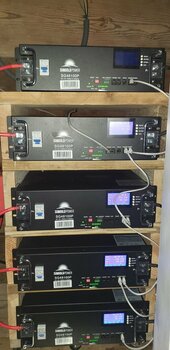CaliSunHarvester
Solar Enthusiast
Hello, I have a battery bank consisting of 5 identical 100Ah rack batteries from SunGoldPower. I built a wooden rack structure to store them. It looks like this:

The walls (left/ right) are 2x8s, and each level's floor is from 2x12s. The rack is open at the back and open at the front. There is a bus "bar" mounted each left and right. The batteries are connected with the manufacturer's wires to the bus:

I am concerned about the uneven use of the 5 batteries.
IIRC, the one at the top shows 10 cycles and the one at the bottom 8.
Yesterday afternoon, all 5 batteries were "full" (100% SOC) and this morning the SOCs were, in order from top to bottom:
60% / 64% / 68% / 73% / 78%
The temperature that each battery reports for its cells is:
25C / 24C / 21C / 20C / 18C
One can feel with his/her hand that the battery on top is quite a bit warmer on the outside as the one at the bottom.
Is this only because heat rises?
Or is #1 warmer because it delivered twice as much energy as #5 (40% vs 22%) ?
For those who have a conventional metal rack: do you observe something similar?

The walls (left/ right) are 2x8s, and each level's floor is from 2x12s. The rack is open at the back and open at the front. There is a bus "bar" mounted each left and right. The batteries are connected with the manufacturer's wires to the bus:

I am concerned about the uneven use of the 5 batteries.
IIRC, the one at the top shows 10 cycles and the one at the bottom 8.
Yesterday afternoon, all 5 batteries were "full" (100% SOC) and this morning the SOCs were, in order from top to bottom:
60% / 64% / 68% / 73% / 78%
The temperature that each battery reports for its cells is:
25C / 24C / 21C / 20C / 18C
One can feel with his/her hand that the battery on top is quite a bit warmer on the outside as the one at the bottom.
Is this only because heat rises?
Or is #1 warmer because it delivered twice as much energy as #5 (40% vs 22%) ?
For those who have a conventional metal rack: do you observe something similar?




